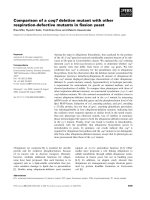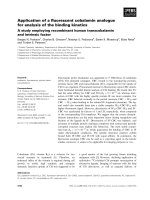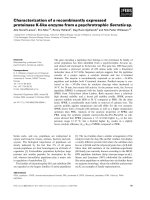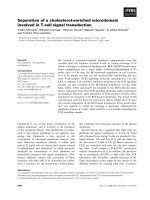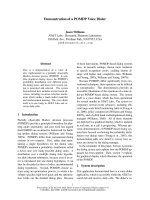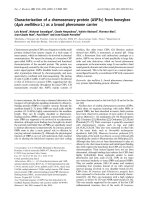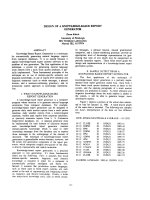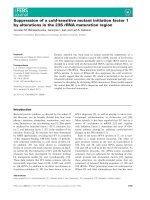Báo cáo khoa học: "Case of a sigmoid colon cancer with metachronous metastases to the mesorectum and the abdominal wall" pdf
Bạn đang xem bản rút gọn của tài liệu. Xem và tải ngay bản đầy đủ của tài liệu tại đây (745.88 KB, 4 trang )
CAS E REP O R T Open Access
Case of a sigmoid colon cancer with
metachronous metastases to the mesorectum
and the abdominal wall
John Kalaitzis
*
, George Filippou, Adamantia Zizi-Sermpetzoglou, Athanasios Marinis, Andrea s Hadjimarcou,
Nikolaos Paschalidis, Spyros Rizos
Abstract
Backround: Sigmoid colon cancer metachronous metastases commonly occur in the liver and lungs with sporadic
reports also to the spleen, stomach, thyroid gland, abdominal wall and upper urinary tract. This is a rare case of
metachronous metastases invading the mesorectum and the abdominal wall.
Case presentation: A 72-year-old female underwent sigmoidectomy for stage I (T2N0 M0) sigmoid colon cancer
in May 2008. In June 2009, an abdominal computed tomography scan revealed a tumor 2 cm in size at the lower
anterior mesorectum and a second mass 2 cm in size at the anterior abdominal wall midline. Total colonoscopy
showed no mucosal lesion. The serum carcinoembryonic antigen level was normal. A biopsy of the mesorectum
tumor showed similar histologic characteristics with the primary tumor. Since no other site of recurrence was
identified, an abdominoperineal resection was attempted. During the operation and after the removal of the
incision recurrence, sinus bradycardia and signs of myocardial ischemia were noticed. A loop transverse colostomy
was immediately perfomed and the operation was terminated. Postoperative cardiologic examination revealed an
acute myocardium infr act. Chemo-radiation of the mesorectum tumor and re-evaluation for surgical excision was
decided.
Conclusion: Metachronous metastasis of the mesorectum from sigmoid colon cancer is extremely rare. Although
patterns of lymphatic spread from rectal cancer to sigmoid colon have recently been demonstrated, there is no
evidence of metachronous mesorectum invasion from sigmoid colon cancer. This could be the issue for future
trials.
Background
Colon cancer as one of the most commonly diagnosed
cancers around the world has an improved prognosis
due to t he development of diagnostic and therapeutic
procedures. Overall survival however, can be seriously
shortened, mostly in the p resence of dis tant metastasis
during follow-up. Liver is the commonest site of meta-
chronous metastases in ap proximately one fourth of the
patients, fol lowed by the lungs [1]. Sporadic reports also
demonstrate the spleen, thyroid gland, stomach, urinary
system and abdominal wall as sites of possible reccur-
ence [2-4]. This is a rare case of a sigmoid colon cancer
with metachronous metastases of the mesorectum and
the abdominal wall.
Case Presentation
A 72-year-old female was admitted to hospital suffering
from fatigue, weight loss and rectal bleeding. Total colono-
scopy demonstrated adenocarcinoma of the sigmoid colon
at 25 cm from the anal verge. A chest x-ray was normal.
No sites of distant metastasis were reported on abdominal
computed tomography (CT) scan. The serum carcinoem-
bryonic antigen level was normal. The patient underwent
sigmoidectomy in May 2008. During the operation, the
left ovary was fixed at the site of the sigmoid colon cancer
and was removed en block. Thorough macroscopic exami-
nation of the liver and rest of the abdomen showed no
sign of metastatic disease. Histopathological examination
* Correspondence:
1stDepartment of Surgery, General Hospital of Pireus Tzaneio, Athens, Greece
Kalaitzis et al. World Journal of Surgical Oncology 2010, 8:17
/>WORLD JOURNAL OF
SURGICAL ONCOLOGY
© 2010 Kalaitzis et al; licensee BioMed Central Ltd. This is an Open Access article distributed under the terms of the Creative Commons
Attribution License ( which permits unrestricted use, dis tribution, and reproduction in
any medium, provided the original work is p roperly cited.
of the specimen r evealed a moderately differentiated
mucus-producing adenocarcinoma, 3 cm in diameter
located 5 cm from the peripheral surgical margin (figur e
1). The tumor invaded into but not beyond the muscularis
propria (T2). Ki 67 antigen and p53 tumor suppressor pro-
tein staining were pos itive and epidermal growth factor
receptor (EGFR) negative. The left ovary was free of neo-
plasmatic tissue. Only four lymph nodes were counted,
free of metastatic adenocarcinoma. The patient had an
uneventful recovery. On rectum examination one year
later a palpable extramucosal mass was noticed at the
anterior rectum wall. An abdominal CT scan revealed a
tumor 2 cm in size at the lower anterior mesorectum in
close relation with the posterior vaginal wall and a second
mass 2 cm in size at the anterior abdominal wall midline
(figure 2, 3). Total colonoscopy showed no mucosal lesion.
A chest x-ray was normal. Rectal endoscopic ultrasound
(EUS) showed a tumor infiltrating the rectum muscularis
propria from outside. C ore needle biopsy demonstrated
the presence of a mucus producing adenocarcinoma with
the same histological futures with the primary tumor and
therefore it was considered as metachronous metastasis.
Serum carcinoembryonic antigen level was normal. Since
no other site of recurrence was identified, an abdomino-
perineal resection was attempted [5]. At laparotomy, the
anterior abdominal wall mass was located at the site of
previous incision and after complete resection, fast biopsy
showed adenocarcinoma. Surgical examination of the
abdominal cavity showed no sign of reccurence. At that
time, sinus bradycardia and ST segment depression was
noticed on electrocardiogram (ECG) monitoring. The ter-
mination of the operation was decided and a loop trans-
verse colostomy was immediately perfomed. Postoperative
cardiologic examination revealed an acute muocardium
infract and the patient was treated respectively. Chemo-
radiation of the mesorectum tumor and re-evaluation for
surgical excision was decid ed and she was dischar ged on
the eleventh post operative day.
Figure 1 Moderately differentiated adenocarcinoma (HE × 200). The glands are lined by neoplastic cells with hyperc hromatic nuclei. The
tumor was accompanied with small mucinous lakes lind by well-differentiated epithelial cells. The tumor invades all intestinal wall.
Figure 2 A pelvic CT showed a tumor 2 cm in size at the lower anterior mesorectum.
Kalaitzis et al. World Journal of Surgical Oncology 2010, 8:17
/>Page 2 of 4
Conclusion
Recurrence afte r curative resection of colon adenocarci-
noma is a major determinant of survival and it seems to
increase as the primary tumor stage advance. In this
case, a sigmoid adenocarcino ma is infiltrating 2/3 of
muscularis propria with four lymph nodes harvested
free of metastatic disease. According to TNM classifica-
tion this is a stage I (TIN0 M0) colon cancer but with
inadequate lymph n ode evaluation [6-8]. Even though
the literature lacks consensus as to what the exact num-
ber of lymph nodes by stage should be, a minimal num-
ber of twelve lymph nodes is recommended [9-13].
Nevertheless, metachronous metastasis to the mesorec-
tum of a moderately differentiated T2 sigmoid adeno-
carcinoma with adequate peripheral surgical margin is
extremely rare. The pathway tumor cells followed is
unknown but one could suspect lymphatic spread. This
is justified by the inadequate lymph node excision. But
even if this is true, downward lymphatic flow is not
common [14,15]. Recently, lymphatic spread from rectal
cancer to the sigmoid colon lymph nodes was demon-
strated in as much as 20% [16]. It seems that lymph
flow is not only towards the paraortic lymph nodes but
follows a more diffuse pattern. In additio n, it is known
that wound recurrence incidence is less than 1% and is
probably a result of impl anted cancer cells on the surgi-
cal wound during removal of the surgical specimen [17].
This case is i mportant in showing that metachronous
metastasis of the mesorectum from sigmoid colon can-
cer is possible, probably due to downward lymphatic
cancer spread. Perhaps, there is a need of a more
thorough investigation of the mesorectum region in sig-
moid colon cancer during preoperative imaging. There
is no similar report published in the literature.
Consent
Written informed consent was obtained from the patient
for publicatio n of this case report and any accompany-
ing images. A copy of the written consent is available
for review by the Editor-in-Chief of this journal.
Acknowledgements
To AH and NP for their general contribution in writing this manuscript.
Authors’ contributions
JK first noticed this rare case report and wrote the main manuscript. GF
revised the manuscript for important intellectual content. AM has been
involved in drafting the manuscript. AZS performed histological examination
of the specimens. SR has given final approval of the version to be published.
Competing interests
The authors declare that they have no competing interests.
Received: 2 January 2010 Accepted: 21 March 2010
Published: 21 March 2010
References
1. Hoshino S, Yanauchi K, Mikami T, Shinohara T: Evaluation of risk factors for
metachronous liver and lung metastasis in colorectal carcinoma. Med
Bull Fukuoka Univ 2007, 34(4):279-283.
2. Rasim Gencosmanoglu, Fugen Aker, Gozde Kir, Nurdan Tozun: Isolated
metachronous splenic metastasis from synchronous colon cancer. World
J Surg Oncol 2006, 4:42.
3. Shirakawa S, Kaneda K, Fujiwara H, Nishimura T, Sendo H, Wada T, Kizaki T:
Case of a sigmoid colon cancer with metachronous metastases of the
stomach and the abdominal wall. Nippon Shokakibyo Gakkai Zasshi 2009,
106(5):653-9.
Figure 3 an Abdominal CT showed enhanced wall thickening in the anterior wall midline.
Kalaitzis et al. World Journal of Surgical Oncology 2010, 8:17
/>Page 3 of 4
4. Mesko TW, Friedman J, Sendzischew H, Nixon DD: Rectal carcinoma
metastatic to the thyroid gland. J Laryngol Otol 1996, 110(2):192-5.
5. Goldberg RM, Fleming TR, Tangen CM, Moertel CG, Macdonald JS,
Haller DG, Laurie JA: Surgery for recurrent colon cancer: strategies for
identifying resectable recurrence and success rates after resection.
Eastern Cooperative Oncology Group, the North Central Cancer
Treatment Group, and the Southwest Oncology Group. Ann Intern Med
1998, 129(1):27-35.
6. NCCN Clinical Practice Guidelines in Oncology ColonCancer V.3.2009. .
7. Compton CC, Greene FL: The staging of colorectal cancer: 2004 and
beyond. Ca Cancer J Clin 2004, 54:295-308.
8. International Union Against Cancer (UICC): Colon and rectum. TNM
classification of malignant tumors New York, NY: WileySobin LH, Wittekind
CH , 6 2002, 72-76.
9. Compton CC, Fielding LP, Burgardt LJ, Conley B, Cooper HS, Hamilton SR,
Hammond ME, Henson DE, Hutter RV, Nagle RB, Nielsen ML, Sargent DJ,
Taylor CR, Welton M, Willett C: Prognostic factors in colorectal cancer.
College of American pathologists consensus statement. Arch Pathol Lab
Med 2000, 124:979-994.
10. Sobin HL, Greene FL: TNM classification. Clarification of number of
regional lymph node for pN0. Cancer 2001, 92(2):452.
11. Le Voyer TE, Sigurdson ER, Hanlon AL, Mayer RJ, Macdonald JS, Catalano PJ,
Haller DG: Colon cancer survival is associated with increasing number of
lunph nodes analyzed: a secondary survey of intergroup trial INT-0089. J
Clin Oncol 2003, 21:2912-2919.
12. Chaplin S, Scerottini G-P, Bosman F-T, Konstanda MT, Givel J-C: For patients
with Duke’s B (TNM stage II) colorectal carcinoma, examination of six or
fewer lymph nodes is related to poor prognosis. Cancer 1998, 83:666-72.
13. Joseph NE, Sigurdson ER, Hanlon AL, Wang H, Mayer RJ, MacDonald JS,
Catalano PJ, Haller DG: Accuracy of determining nodal negativity in
colorectal cancer on the basis of number of nodes retrieved on
resection .
14. Kobayashi Y, Fujita S, Yamaguchi T, Yamamoto S, Akasu T, Moriya Y:
Optimum lymph node dissection in clinical T1 and clinical T2 colorectal
cancer. Dis Colon Rectum 2009, 52(5):942-9.
15. Canessa CE, Badía F, Fierro S, Fiol V, Háyek G: Anatomic study of the
lymph nodes of the mesorectum. Dis Colon Rectum 2001, 44(9):1333-6.
16. Park IJ, Choi GS, Lim KH, Kang BM, Jun SH: Metastasis to the sigmoid or
sigmoid mesenteric lymph nodes from rectal cancer. Ann Surg 2009,
249:960-964.
17. Reilly WT, Nelson H, Schroeder G, Wieand HS, Bolton J, O’Connell MJ:
Wound recurrence following conventional treatment of colorectal
cancer. A rare but perhaps underestimated problem. Dis Colon Rectum
1996, 39(2)
:200-7.
doi:10.1186/1477-7819-8-17
Cite this article as: Kalaitzis et al.: Case of a sigmoid colon cancer with
metachronous metastases to the mesorectum and the abdominal wall.
World Journal of Surgical Oncology 2010 8:17.
Submit your next manuscript to BioMed Central
and take full advantage of:
• Convenient online submission
• Thorough peer review
• No space constraints or color figure charges
• Immediate publication on acceptance
• Inclusion in PubMed, CAS, Scopus and Google Scholar
• Research which is freely available for redistribution
Submit your manuscript at
www.biomedcentral.com/submit
Kalaitzis et al. World Journal of Surgical Oncology 2010, 8:17
/>Page 4 of 4

